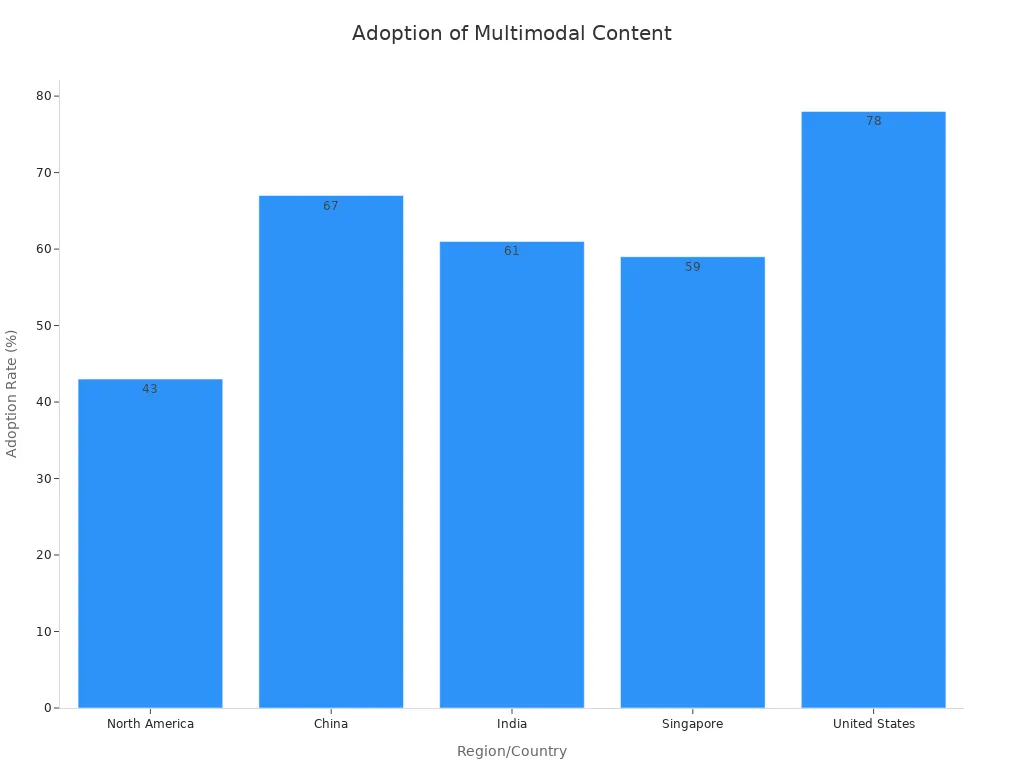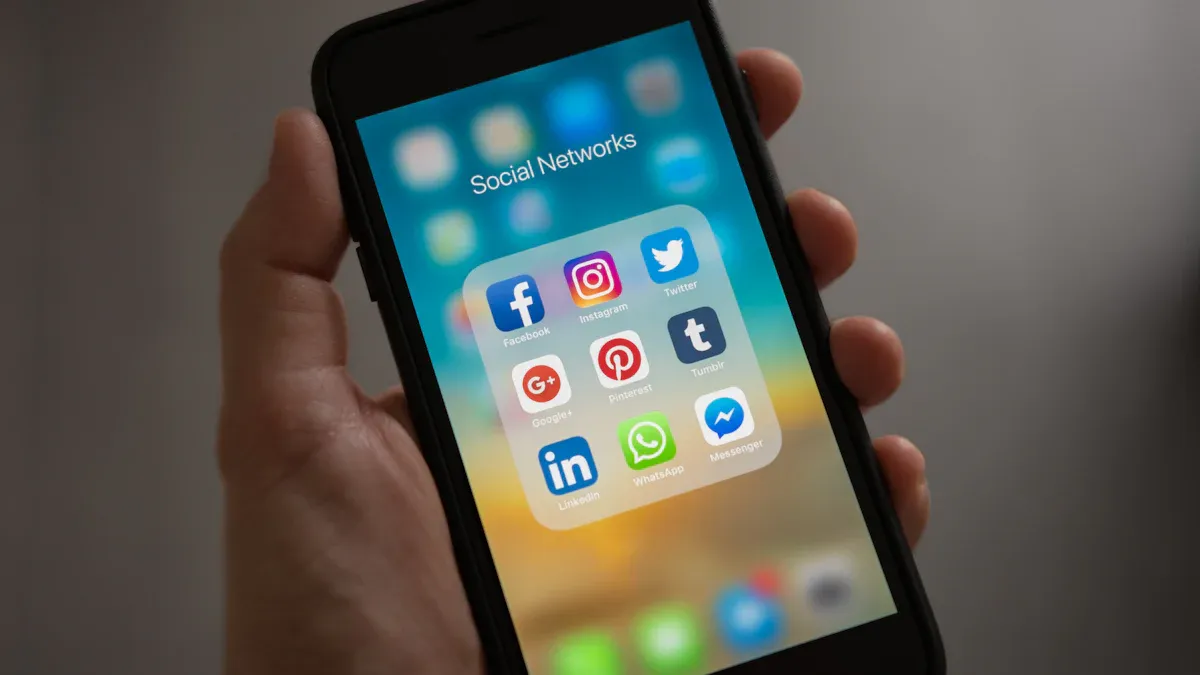
Multimodal Content Generation lets you blend text, images, audio, and video to tell your brand’s story in a way that feels dynamic and personal. Brands worldwide now use AI to create content that connects on a deeper level. Just look at the numbers:
|
Adoption Rate |
Additional Key Statistics |
|
|---|---|---|
|
North America |
43% market share |
Leading global market share in AI writing tools |
|
China |
67% adoption |
78% of tech companies use AI for content generation; 83% growth since 2023 |
|
India |
61% adoption |
73% of software companies use AI; 92% of large corporations plan to increase investments in 2026 |
|
Singapore |
59% adoption |
71% AI adoption driven by government initiatives; 81% in financial services sector |
|
United States |
78% of organizations |
70 million monthly ChatGPT users; 85% planning to increase AI investments in 2025; 61% content creators use AI tools regularly |

AI models now understand and generate content that feels as natural as a real conversation. When you mix media types, you boost engagement and build trust, making your brand stand out in a crowded digital world.
Key Takeaways
-
Multimodal content combines text, images, audio, and video to tell your brand’s story in a more engaging and relatable way.
-
Using multiple media types boosts audience attention, trust, and conversions, helping your brand stand out in a crowded market.
-
Set clear goals and understand your audience’s needs to choose the best content mix and channels for your brand.
-
Mix different content formats like text with emoticons, videos, and audio to keep your content fresh and reach more people.
-
Leverage AI tools to create, personalize, and optimize multimodal content faster while tracking key metrics to improve results.
Multimodal Content Generation

What It Is
Multimodal Content Generation means you create content that combines text, images, audio, and video. You do not just stick to one format. Instead, you mix different types of media to tell your brand’s story in a more powerful way. This approach helps you reach people who like to read, watch, or listen.
AI makes this process much easier. Large multimodal models (LMMs) can understand and generate content across many formats. You can use these tools to write blog posts, design graphics, create videos, or even produce podcasts—all from a single prompt. AI tools help you save time and keep your brand’s voice consistent.
You see this trend in many industries:
-
The technology sector leads the way, with 56% of generative AI projects using multimodal strategies.
-
Manufacturing and professional services are catching up, with 8% and 7% adoption rates.
-
Teams in customer support, marketing, IT, operations, and R&D use these tools to boost productivity.
-
North America stands out, with 56% of projects happening there.
Some industries, like pharmaceuticals, use multimodal AI to combine data from different sources—like clinical records, images, and chemical data. This helps them find new drugs faster and work better as a team.
Why It Matters
You might wonder why you should care about Multimodal Content Generation. The answer is simple: it works. When you use more than one type of media, you grab people’s attention and keep them interested. Your brand feels more real and relatable.
A recent study looked at 5,000 Reddit posts from brand communities. The results showed that posts with a mix of text, images, and videos led to more engagement and better business results. People searched for those brands more often and stuck around longer. Here’s what happened when a fashion brand used videos and images in their campaign:
|
Metric |
Impact Percentage |
|---|---|
|
Engagement |
30% |
|
Website Traffic |
25% |
|
Conversions |
45% |
You can see that engagement jumped by 30%, website visits rose by 25%, and conversions shot up by 45%. That’s a big difference.
Multimodal Content Generation also helps you stand out. Here are some ways brands use it to get ahead:
-
Industry-specific content builds trust and authority, leading to higher engagement.
-
Case studies and testimonials give real proof, making your brand more believable.
-
Localized content adapts to different cultures, so you connect with more people.
-
Formats like videos, infographics, and testimonials make your message stick.
Personalization takes things even further. When you use AI to tailor content, you can double your engagement rates. Personalized emails get six times more transactions than regular ones. Campaigns with AI-driven personalization see 1.7 times more conversions. Customer satisfaction can jump by 30%, and you can reduce customer churn by 28%. Companies even report a 25% boost in marketing ROI after using AI personalization. Big names like Netflix and Amazon save money and make more sales by recommending the right content to the right people.
Tip: Try mixing different content types and use AI tools to personalize your message. You’ll see better results and build stronger relationships with your audience.
Goals and Audience
Brand Objectives
Before you start creating multimodal content, you need to set clear goals for your brand. Think about what you want to achieve. Do you want more website traffic, higher engagement, or better conversions? Setting the right objectives helps you focus your efforts and measure your success.
Here’s a simple way to define your brand’s objectives:
-
Set marketing goals and KPIs that match your business targets. This keeps your campaigns focused.
-
Research your audience. Learn about their age, habits, pain points, and favorite channels.
-
Pick the best mix of channels based on what you learn. Focus on where your audience spends time.
-
Use data tools to track everything. This helps you see what works and make smart decisions.
-
Build a plan that puts your customers first. Keep your message clear and consistent. Personalize when you can, and stay flexible.
Did you know? Email marketing can give you $42 for every $1 you spend. Video marketing can boost conversions by up to 86%. Choosing the right channels really pays off.
You can also use tools like Mural’s AI templates to brainstorm ideas and organize your strategy. This makes it easier to set clear goals and plan your content.
Audience Needs
To connect with your audience, you need to understand what they want and how they interact with your content. People look for content that feels real and speaks their language. They want stories, not just ads.
-
Use both visuals and words to explain things, especially if your audience comes from different cultures.
-
Share stories from everyday life. Use simple language and close-up shots to make your brand feel personal.
-
Mix images, sounds, and animations to make your content more engaging and accessible.
-
Social media, like TikTok, works best for storytelling and building a community, not just selling.
-
People want content that goes deeper, answers their questions, and sparks curiosity.
If you keep your audience’s needs in mind, your multimodal content will feel more meaningful and memorable.
Content Types

Formats
You have so many ways to share your brand’s story. Each format brings something special to the table. Here are some popular options you can use:
-
Text: Great for sharing details, stories, or instructions.
-
Images: Perfect for catching attention and showing off products.
-
Video: Helps you explain ideas quickly and keeps people watching.
-
Audio: Podcasts and voice notes make your brand feel personal.
-
Emoticons: Add emotion and make your message feel friendly.
You might think videos or pictures always boost engagement, but that’s not always true. Sometimes, simple text with emoticons gets people talking more. Take a look at this table to see how different combinations affect likes, shares, and comments:
|
Multimodal Content Type |
Likes |
Shares |
Comments |
Effect on Engagement |
|---|---|---|---|---|
|
Text + Emoticon |
— |
↓ |
↑ |
More comments, fewer shares |
|
Text + Picture |
↓ |
↓ |
↓ |
Less engagement overall |
|
Text + Video |
↓ |
↓ |
↓ |
Less engagement overall |
Note: Emoticons can spark more comments, while pictures and videos might not always get the results you expect. It depends on your audience and the message.
Mix and Match
You do not have to stick with just one format. Mixing things up can help you reach more people and keep your content fresh. Try these ideas:
-
Pair text with emoticons to make your posts feel warm and inviting.
-
Use short videos with captions for quick tips or behind-the-scenes looks.
-
Combine images with simple stories to show real-life moments.
-
Add audio clips to blog posts for a personal touch.
Remember, the best mix depends on your audience. Some people love videos, while others prefer reading or listening. Test different combinations and see what works. When you use the right formats together, you can boost engagement and make your brand stand out.
AI Tools and Models
Tool Selection
Choosing the right AI tools can make your Multimodal Content Generation process smoother and more creative. You have many options today. Large multimodal models (LMMs) like OpenAI’s GPT-4o, Google Gemini, and Meta’s Llama 3 can handle text, images, and even audio or video. Retrieval-Augmented Generation (RAG) tools help you ground your content in real company data, keeping your brand voice and facts accurate. Multimodal Content Toolkits (MCTs) let you mix and match formats for different channels.
Here are some ways AI tools help brands like yours:
-
Text-to-video tools use huge video libraries to turn your ideas into short clips.
-
Voice cloning creates lifelike audio for podcasts or ads.
-
Lip-sync avatars make your videos feel more real by matching speech with facial movements.
-
AI can link video transcripts with time codes, making editing much faster.
-
Generative AI builds custom learning content, like podcasts or training videos, for your team or customers.
Recent research shows that 93% of marketers use AI to create content faster. About 81% use it to find insights quickly, and 90% say AI helps them make decisions faster. Most B2B marketers who use generative AI feel satisfied with the results.
Integration
You want your workflow to feel easy and your brand to stay consistent. Start by picking tools that fit your needs and work well with your current systems. Many AI platforms offer plugins or APIs, so you can connect them to your website, social media, or design software.
Try to keep your content grounded in your brand’s own data. This helps you stay on message and follow compliance rules, especially if you work in industries like healthcare or finance. AI can help you automate tasks, personalize content, and reach your audience on the right channels.
You see these tools in action across many fields. Media and entertainment companies use AI to speed up video production. Drug discovery teams combine text, images, and chemical data to find new treatments. No matter your industry, integrating AI tools can boost creativity, save time, and help you deliver more engaging experiences.
Personalization and Optimization
Channel Adaptation
You want your content to shine on every platform. Each digital channel has its own style and audience. What works on Instagram might not work on LinkedIn or TikTok. Research from the IAB shows that people behave differently on each platform. Some scroll quickly, while others stop and watch. You need to match your content to these habits.
Industry reports highlight how streaming, AI-driven recommendations, and even VR are changing the way people interact with brands. You should create content that fits each channel’s strengths. For example, use short, catchy videos for TikTok, but share in-depth guides or case studies on LinkedIn. When you adapt your content, you reach more people and keep them interested.
Tip: Test your content on different platforms. Track what gets the most attention and adjust your strategy.
Performance Metrics
You can’t improve what you don’t measure. Brands use many metrics to see if their multimodal content works. Here’s a quick look at some key metrics and tools:
|
Metric Category |
Description |
Tools/Methods |
|---|---|---|
|
Referral Traffic Analysis |
Tracks visitors from backlinks and social platforms, focusing on engagement quality. |
Traffic analytics tools |
|
Brand Mention Tracking |
Measures how often and how positively people mention your brand online. |
Social listening tools |
|
Social Engagement Metrics |
Looks at real interactions like comments and shares, not just views. |
Social media analytics |
|
Conversion Attribution |
Shows how different channels help turn visitors into customers. |
Attribution modeling tools |
|
ROI Calculation |
Connects your content efforts to actual revenue. |
ROI modeling frameworks |
You should focus on quality over quantity. It’s better to reach the right people and spark real conversations than just chase big numbers.
Best Practices
You can boost your workflow and results by following a few simple steps:
-
Automate boring tasks like keyword research and scheduling with AI tools.
-
Use dashboards to track your progress and spot trends.
-
Mix AI automation with your own creativity for the best results.
-
Keep refining your process by checking efficiency and quality metrics.
Note: AI tools help you save time, create more content, and improve quality. They also give you real-time feedback so you can keep getting better. When you combine smart tools with your unique ideas, your brand stands out and grows.
You now have the tools to build powerful multimodal content for your brand. Start by aligning your team, setting clear goals, and using content pillars that match your audience’s interests. Try new formats like video, interactive posts, or webinars. Track your results and keep learning as AI changes.
Don’t be afraid to experiment. The brands that grow fastest use collaboration, smart metrics, and fresh ideas. Dive in and let multimodal content take your brand to the next level!
FAQ
What is multimodal content?
Multimodal content uses more than one type of media. You might see text, images, audio, or video all working together. This mix helps you reach people who like to read, watch, or listen.
How do I choose the right formats for my brand?
Start by thinking about your audience. Ask what they like and where they spend time online. Try different formats. Track what works best. You can always adjust your mix as you learn more.
Can I use AI tools if I have no tech background?
Yes! Many AI tools have simple interfaces. You can drag and drop, use templates, or follow step-by-step guides. You do not need to code. Just explore and experiment.
How do I measure if my multimodal content works?
Look at key metrics like engagement, shares, and conversions. Use analytics tools to track results. Focus on quality interactions, not just big numbers. Adjust your strategy based on what you see.
